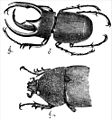This article needs additional citations for verification. (December 2024) |
| Atlas beetle | |
|---|---|

| |
| Scientific classification | |
| Domain: | Eukaryota |
| Kingdom: | Animalia |
| Phylum: | Arthropoda |
| Class: | Insecta |
| Order: | Coleoptera |
| Suborder: | Polyphaga |
| Infraorder: | Scarabaeiformia |
| Family: | Scarabaeidae |
| Genus: | Chalcosoma |
| Species: | C. atlas
|
| Binomial name | |
| Chalcosoma atlas | |
The Atlas beetle (Chalcosoma atlas) is a very large species of beetle in the family Scarabaeidae, found in Southeast Asia. Males have three prominent horns. The species is named for Atlas, the giant of Greek mythology who supported the skies.
Description
[edit]
Chalcosoma atlas, like other beetles of the genus Chalcosoma, is remarkable for its size. As is common in the Scarabaeidae, males are larger than the females, reaching a length of about 60–120 millimetres (2.4–4.7 in); females are about 25–60 millimetres (0.98–2.36 in). Males have specialised horns on their head and thorax that they use to fight with each other, to gain mating rights with females. The Atlas beetle differs from other Chalcosoma species (such as C. caucasus) by the broader end of the cephalic (head) horn.
Larvae
[edit]The larva of the Atlas beetle is known for its fierce behavior, including biting if touched. Unverified reports exist of larvae that live together fighting to the death if they have insufficient space or food.[citation needed]
Distribution
[edit]Chalcosoma atlas is found in Southeast Asia.
Parasitoids
[edit]The species is the host of a parasitoid, the giant scoliid wasp Megascolia procer, which has a paralysing venom.[1]
Subspecies
[edit]- Chalcosoma atlas atlas (Linnaeus, 1758)- Sulawesi
- Chalcosoma atlas butonensis Nagai, 2004- Buton island
- Chalcosoma atlas keyboh Nagai, 2004- Malaysia and Sumatra
- Chalcosoma atlas mantetsu Nagai, 2004- Thailand and Vietnam
- Chalcosoma atlas simeuluensis Nagai, 2004- Simeulue island
- Chalcosoma atlas sintae Nagai, 2004- Peleng islands
- Chalcosoma atlas hesperus (Erichson, 1834)- Philippines
Gallery
[edit]-
Sexual dimorphism in Chalcosoma atlas. From Darwin's The Descent of Man, 2nd edn. 1882.
-
Males of Chalcosoma atlas
-
Females of Chalcosoma atlas
-
Male, showing broadened cephalic horn
References
[edit]- ^ Piek, Tom (22 October 2013). Venoms of the Hymenoptera: Biochemical, Pharmacological and Behavioural Aspects. Elsevier. p. 173. ISBN 978-1-4832-6370-0.
External links
[edit] Data related to Chalcosoma atlas at Wikispecies
Data related to Chalcosoma atlas at Wikispecies Media related to Chalcosoma atlas at Wikimedia Commons
Media related to Chalcosoma atlas at Wikimedia Commons- Biolib
- Kazuo Kawano Character Displacement in Giant Rhinoceros Beetles



